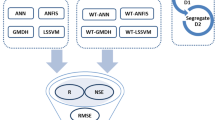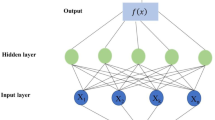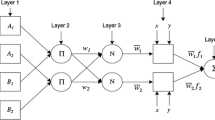Abstract
As a computational method with impressive performance over traditional methods, Artificial Intelligence (AI) has recently gained great attention. It is a consortium of different soft-computational methodologies including artificial neural networks (ANNs), Fuzzy Logic (FL), Wavelet Transformation (WT) and so forth. AI recently begun to explain complex and non-linear problems in geoscience and hydrology in a clear and satisfactory manner. The combination of one and more approaches has created, rather than applying one approach, new categories such as Neuro-Fuzzy (NF), which are more effective than distinct approaches. Considering the recognition and huge application and promotion of AI procedures in geoscience and hydrology since last few years, it would be an vital chore to deduce the distinctive new use of the AI techniques in groundwater investigation. It was therefore our goal to exhibit the use of AI to take care of the perplexing and nonlinear issues in the field of groundwater research. In this chapter we have attempted to emphasize the learning of individual and hybrid AI techniques in groundwater studies, introduce and apply them. We mainly described different individual and combined soft-computing tools like Fuzzy logic, Sugeno fuzzy logic, Neurofuzzy, Gradient-based groundwater model, Artificial Neural Network, Support Vector Machine, and Wavelet transform to assess and monitor groundwater resources. Long-term applications and advancement of AI procedure for precise appraisal of groundwater assets is additionally proposed.
Access this chapter
Tax calculation will be finalised at checkout
Purchases are for personal use only
Similar content being viewed by others
References
Adamowski, J. (2008). River flow forecasting using wavelet and cross-wavelet transform models. Hydrological Processes, 22, 4877–4891.
Adamowski, J., Chan, H. F. (2011) A wavelet neural network conjunction model for groundwater level forecasting. Journal of Hydrology, 407(1–4), 28–40.
Adhikary, P. P., Sena, D. R., Dash, C. J., Mandal, U., Nanda, S., Madhu, M., et al. (2019). Effect of calibration and validation decisions on streamflow modeling for a heterogeneous and low runoff-producing river basin in India. Journal of Hydrologic Engineering, 24(7), 05019015.
Alagha, J.S., Md Azlin, Md Said, & Mogheir, Y. Artificial intelligence-based modelling of hydrological processes. In The 4th International Engineering Conference—Towards Engineering of 21st Century (pp. 1–13).
Alagha, J. S., Md Azlin, Md, & Said, Mogheir Y. (2013). Improving the accuracy of artificial intelligence—Based groundwater quality models using clustering technique—A case study. American Journal of Environmental Engineering, 3(2), 100–106.
Aller, L., Bennett, T., Lehr, J. H., Petty, R. J., & Hackett, G. (1987). DRASTIC: a standardized 14 system for evaluating ground water pollution potential using hydrogeologic settings, EPA 15 600/2-87-035. Ada, Oklahoma: U.S. Environmental Protection Agency.
Behzad, M., Asghari, K., & Coppola, E. (2010). Comparative study of SVMs and ANNs in aquifer water level prediction. Journal of Computing in Civil Engineering, ASCE, 24(5), 408–413.
Burggräf, P., Wagner, J., & Koke, B. (2018). Artificial intelligence in production management. In International Conference on Information Management and Processing (pp. 82–88). Available at: file:///C:/Users/HP/Downloads/ICIMP_Paper_Extract.pdf
Chen, S. H., Jakeman, A. J., & Norton, J. P. (2008). Artificial intelligence techniques: An introduction to their use for modelling environmental systems. Mathematics and Computers in Simulation, 78(2), 379–400.
Coppola, E., Szidarovszky, F., Poulton, M., & Charls, E. (2003). Artificial neural network approach for predicting transient water levels in multilayered groundwater system under variable state, pumping, and climate conditions. Journal of Hydrologic Engineering, 8, 348–380.
Demirci, M., Üneş, F., & Körlü, S. (2019). Modeling of groundwater level using artificial intelligence techniques: A case study of Reyhanlı region in Turkey. Applied Ecology and Environmental Research, 17(2), 2651–2663.
Dixon, B. (2005). Application of neuro-fuzzy techniques in predicting groundwater vulnerability: A GIS based sensitivity analyses. Journal of hydrology, 309(1–4), 17–38.
Djurovic, N., Domazet, M., Stricevic, R., Pocuca, V., Spalevic, V., Pivic, R., Gregoric, E., et al. (2015). Comparison of groundwater level models based on artificial neural networks and ANFIS. The Scientific World Journal, 13. Article ID 742138. http://dx.doi.org/10.1155/2015/742138
Emamgholizadeh, S., Moslemi, K., & Karami, G. (2014): Prediction the groundwater level of Bastam plain (Iran) by artificial neural network (ANN) and adaptive neuro-fuzzy inference system (ANFIS). Water Resources Management, 28(15), 5433–5446.
Fallah-Mehdipour, F., Haddad, O. B., & Mariño, M. A. (2014). Genetic programming in groundwater modeling. Journal of Hydrologic Engineering, 19(12).
Fijani, E., Nadiri, A. A., Moghaddam, A. A., Tsai, F. T. C., & Dixo, B. (2013). Optimization of DRASTIC method by supervised committee machine artificial intelligence to assess groundwater vulnerability for Maragheh-Bonab Plain Aquifer, Iran. Journal of Hydrology. doi: http://dx.doi.org/10.1016/j.jhydrol.
Galelli, S., Humphrey, G. B., Maier, H. R., Castelletti, A., Dandy, G. C., & Gibbs, M. S. (2014). An evaluation framework for input variable selection algorithms for environmental data-driven models. Environmental Modelling & Software, 62, 33–51.
Govindaraju, R. S., & Rao, A. R. (2000). Artificial neural networks in hydrology. Water Science and Technology Library (Vol. 36). Dordrecht, The Netherlands: Springer.
Guzman, S. M., Paz, J. O., Tagert, M. L. M., & Mercer, A. (2015). Artificial neural networks and support vector machines: Contrast study for groundwater level prediction—2015 ASABE Annual International Meeting. American Society of Agricultural and Biological Engineers, St. Joseph, MI, p. 1
Harbaugh, A. W. (2005). Modflow-2005, The U.S. Geological Survey modular ground-water model–the ground-water flow process. Techniques and Methods Book 6-A16, U. S. Geol. Survey, Denver, CO Available at: http://pubs.usgs.gov/tm/2005/tm6A16/PDF/TM6A16.pdf
Heesung, Y., Jun, S. C., Yunjung, H., Bae, G. O., & Kang, K. L. (2011). A comparative study of artificial neural networks and support vector machines for predicting groundwater levels in a coastal aquifer. Journal of Hydrology, 396, 128–138.
Jiao, S., Yu, J., Milas, A. S., Li, X. J., & Liu, L. M. (2017). Assessing the impact of building volume on land subsidence in the central Business District of Beijing with SAR tomography. Canadian Journal of Remote Sensing, 43(2), 177–193.
Junping, L., Mingqi, C., & Xiaoyan, M. A. (2009). Groundwater quality assessment based on support vector machine, paper funded by global environment fund (GEF) integral water resource and environment management of Haihe River basin (MWR-9-2-1). “111” Introducing Intelligence Project (B08039).
Kenda, K., Čerin, M., Bogataj, M., Senožetnik, M., Klemen, K., Pergar, P., Laspidou, C., & Mladenić, D. (2018). Groundwater modeling with machine learning techniques: Ljubljana polje Aquifer. Proceedings (Vol. 2, p. 697). https://doi.org/10.3390/proceedings2110697
Khaki, M., Yusoff, I., & Islami, N. (2015). Simulation of groundwater level through artificial intelligence system. Environmental Earth Sciences, 73(12), 8357–8367.
Khalil, M. I., Rasul, G., Majumder, R. K., Kabir, M. Z., Deeba, F., Islam, F., Karmaker, S., Jalal Uddin Rumi, K. M., Siddique, R. (2015). Erratum to: Geo-electrical soundings and analysis to investigate groundwater aquifers at Khulna City, coastal area of Bangladesh. Arabian Journal of Geosciences, 8(8), 5335–5335.
Kisi, O. (2010). Daily suspended sediment estimation using neuro-wavelet models. International Journal of Earth Sciences, 99, 1471–1482.
Kouziokas, G. N., Chatzigeorgiou, A., & Perakis, K. (2017). Artificial intelligence and regression analysis in predicting ground water levels in public administration. European Water, 57, 361–366.
Kouziokas, G. N. (2016). Artificial intelligence and crime prediction in public management of transportation safety in urban environment. In Proceedings of the 3rd conference on sustainable urban mobility (pp. 534–539). Volos: University of Thessaly Greece.
Lee, C. (1990) Fuzzy logic in control systems: Fuzzy logic controller, Parts I and II. IEEE Transactions on systems, man, and cybernetics, 20, 404–435.
Li, J., Wang, H. O., Bushnell, L., Hong, Y., Tanaka, K. (2000). A fuzzy logic approach to optimal control of nonlinear systems. International Journal of Fuzzy Systems, 2(3), 153–163.
Lohani, A. K., Goel, N. K., Bhatia, K. K. (2006). Takagi-Sugeno fuzzy inference system form modeling stage-discharge relasionship. Journal of Hydrology, 331, 146–160.
Lohani, A. K., & Krishan, G. (2015). Application of artificial neural network for groundwater level simulation in Amritsar and Gurdaspur Districts of Punjab, India. Journal of Earth Science and Climatic Change, 6(4), 1–5.
Mallat, S. G. (1998). A Wavelet Tour of Signal Processing (2nd ed.). San Diego: Academic Press.
McCulloch, W. (1984). A logical calculus of the ideas immanent in nervous activity (Vol. 5). Bulletin of Mathematical Biophysics.
Millington, I. (2006). Artificial intelligence for games. San Francisco, CA, USA: Morgan Kaufmann Publishers Inc.
Mohanty, S., Jha, M. K., Kumar, A., & Sudheer, K. P. (2010). Artificial neural network modelling for groundwater level forecasting in a river is land of eastern India. Water Resources Management, 24(9), 1845–1865.
Nauck, D., & Kruse, R. (1999). Neuro-fuzzy systems for function approximation. Fuzzy Sets and Systems, 101, 261–271.
Nayak, P. C., Sudheer, K. P., Rangan, D. M., & Ramasastri, K. S. (2004). A neuro-fuzzy computing technique for modeling hydrological time series. Journal of Hydrology, 291, 52–66.
Nourani, V., Baghanam, A. H., Adamowski, J., & Kisi, O. (2014). Applications of hybrid wavelet–Artificial intelligence models in hydrology: A review. Journal of Hydrology, 514, 358–377.
Nourani, V., Alami, M. T., & Vousoughi, F. D. (2015). Wavelet-entropy data preprocessing approach for ANN-based groundwater level modeling. Journal of Hydrology, 524, 255–269.
Pang, B., Lee, L. (2004). A sentimental education: Sentiment analysis using subjectivity summarization based on minimum cuts. In: Proceedings of the 42nd annual meeting of the association for computational linguistics, 271–278.
Quilty, J., Adamowski, J., Khalil, B., & Rathinasamy, M. (2016). Bootstrap rank-ordered conditional mutual information (broCMI): A nonlinear input variable selection method for water resources modelling. Water Resources Research
Rahman, A. (2008). A GIS based model for assessing groundwater vulnerability in shallow 11 aquifer in Aligarh, India. Applied Geography, 28, 32–53.
Reinecke, R., Foglia, L., Mehl, S., Trautmann, T., Cáceres, D., & Döll, P. (2019). Challenges in developing a global gradient-based groundwater model (G3M v1.0) for the integration into a global hydrological model. Geoscientific Model Development, 12, 2401–2418. https://doi.org/10.5194/gmd-12-2401-2019.
Sadeghfam, S., Hassanzadeh, Y., Khatibi, R., Nadiri, A. A., & Moazamnia, M. (2019). Groundwater remediation through pump-treat-inject technology using optimum control by artificial intelligence (OCAI). Water Resources Management, 33(3), 1123–1145.
Sang, Y. F. (2012). A practical guide to discrete wavelet decomposition of hydrologic time series. Water Resources Management, 26(11), 3345–3365.
Schmidt, F., Wainwright, H. M., Faybishenko, B., Denham, M., & Eddy-Dilek, C. (2018). In situ monitoring of groundwater contamination using the Kalman filter. Environmental Science and Technology, 52(13), 7418–7425.
Singh, K. P., Basant, A., Malik, A., & Jain, G. (2009). Artificial neural network modeling of the river water quality—A case study. Ecological Modelling, 220, 888–895.
Srinivasulu, S., & Jain, A. (2006). A comparative analysis of training methods for artificial neural network rainfall–runoff models. Applied Soft Computing, 6, 295–306.
Suykens, J. A., Vandewalle, J. P., & de Moor, B. L. (2012). Artificial neural networks for modelling and control of non-linear systems. Springer Science & Business Media.
Taiyuan, F., Shaozhong, K., Zailin, H., Shaqiun, C., & Xiaomin, M. (2007). Neural networks to simulate regional ground water levels affected by human activities. Groundwater, 46, 80–90.
Umamaheswari, G. R., & Kalamani, D. (2014). Fuzzy logic model for the prediction of groundwater level in Amaravathi River Minor Basin. International Journal of Mathematics Trends and Technology, 11(1), 46–50.
Wang, J., Narain, D., Hosseini, E. A., Jazayeri, M. (2018). Flexible timing by temporal scaling of cortical responses. Nature Neuroscience, 21(1), 102–110.
Yarar, A., Onucyıldız, M., & Copty, N. K. (2009). Modelling level change in lakes using neuro-fuzzy and artificial neural networks. Journal of Hydrology, 365, 329–334.
Zadeh, L. A. (1965). Fuzzy sets. Information and Control, 8(3), 338–353
Zare, M., & Koch, M. (2018). Groundwater level fluctuations simulation and prediction by ANFIS-and hybrid Wavelet-ANFIS/Fuzzy C-Means (FCM) clustering models: application to the Miandarband plain. Journal of Hydro-Environment Research, 18, 6376.
Zhang, W. J., Gao, L., Jiao, X., Yu, J., Su, X. S., & Du, S. H. (2014). Occurrence assessment of earth fissure based on genetic algorithms and artificial neural networks in Su-xi-Chang land subsidence area, China. Journal of Geosciences, 18(4), 485–493.
Author information
Authors and Affiliations
Corresponding author
Editor information
Editors and Affiliations
Rights and permissions
Copyright information
© 2021 Springer Nature Switzerland AG
About this chapter
Cite this chapter
Bhunia, G.S., Shit, P.K., Adhikary, P.P. (2021). Concept of Artificial Intelligence and Its Applications in Groundwater Spatial Studies. In: Adhikary, P.P., Shit, P.K., Santra, P., Bhunia, G.S., Tiwari, A.K., Chaudhary, B.S. (eds) Geostatistics and Geospatial Technologies for Groundwater Resources in India. Springer Hydrogeology. Springer, Cham. https://doi.org/10.1007/978-3-030-62397-5_3
Download citation
DOI: https://doi.org/10.1007/978-3-030-62397-5_3
Published:
Publisher Name: Springer, Cham
Print ISBN: 978-3-030-62396-8
Online ISBN: 978-3-030-62397-5
eBook Packages: Earth and Environmental ScienceEarth and Environmental Science (R0)




